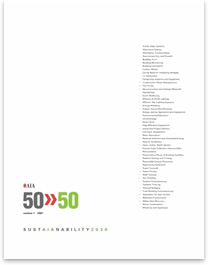sustainABILITY
50 Principles for Immediate Carbon Reduction
AIA publication available on-line
 Summary: 50 to 50 is a compendium of 50 principles you can implement now to reduce the carbon footprint of a building by 50 percent of a building that does not employ these strategies. It is intended to be an informative and easily accessible reference to provide a basic understanding of these strategies as the first step toward the goal of making new and renovated building carbon neutral by 2030. Summary: 50 to 50 is a compendium of 50 principles you can implement now to reduce the carbon footprint of a building by 50 percent of a building that does not employ these strategies. It is intended to be an informative and easily accessible reference to provide a basic understanding of these strategies as the first step toward the goal of making new and renovated building carbon neutral by 2030.
The AIA’s 50to50 is a how-to resource intended to assist architects and the construction industry in moving toward the AIAís public goal of a minimum 50 percent reduction of fossil fuel consumption in buildings by 2010 and carbon neutrality by 2030.
The AIA has been committed to sustainability as an important component of quality design for more than 30 years. The Institute understands that sustainability means much more than energy conservation alone and has maintained a strong commitment to sustainability in the broadest sense of the term. Growing evidence of global climate change as the result of increased production of greenhouse gases has necessitated some new priorities.
The AIA recognizes that buildings are responsible for approximately 48 percent of energy consumption in the United States. Ongoing operation and maintenance of buildings account for approximately 76 percent of U.S. electrical use. With these facts alone, it isnít hard to establish buildings as one of the primary sources of the greenhouse gases contributing to global warming and climate change. This realization has established carbon reduction as the top priority of the Instituteís sustainability initiative.
The 50 strategies have been selected to provide readily available and effective tools and techniques that will have an effective and immediate impact on architectsí ability to achieve significant carbon reduction. The strategies span a spectrum from broad-based site and planning objectives to specific, building-based concepts. Each strategy includes an overview of the subject, typical applications, emerging trends, links to information sources, and important relationships to other carbon reduction strategies. |



